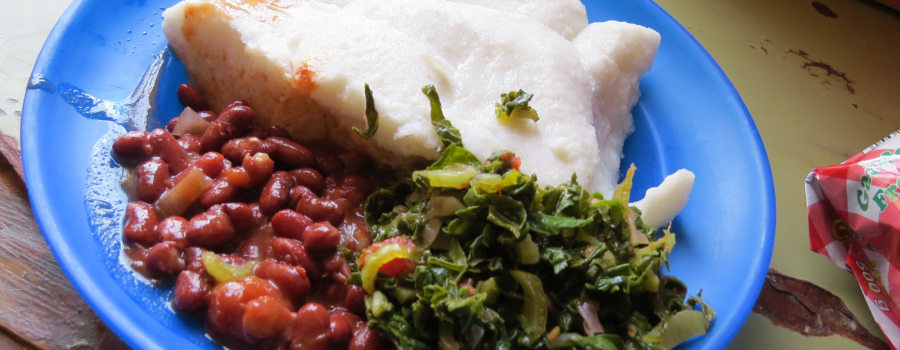Exploring foods of other cultures is a joy. I love doing so both while living in the United States and traveling or working abroad. I have had the fortune to work in several countries with excellent culinary traditions.
Several years ago, I spent several months in Kumasi, Ghana. Near the grounds of Komfo Anokye Teaching Hospital, where I was working, was a small restaurant. I had lunch there each weekday and was sad on the weekends when they were closed. Obtaining food required patience as there was always a line out the door. When I finally reached the counter, a lovely woman greeted me and asked what I wanted. Though Ghana is known for its soups and stews, ninety percent of the time I answered, “red red.” Plantains are cut on a diagonal, rolled in gentle spices and deep fried. A small mountain of this gorgeous yellow heaven is covered with soft, perfectly cooked black eyed peas in a tomato “gravy.” After picking up my mountain of food I paid my $1.50, selected a freezing cold bottle of ginger beer, and made my way outside to the covered patio. There I sat, sweating and happy, delighting in this sweet, salty, spicy deliciousness.
One day per week, though, to break the pattern, I ordered fufu. I think I did so because I liked saying the word. Fufu is a spicy soup served over a semi-solid white paste made of yam, cassava, banana, and/ or taro. The blandness of the paste is counterbalanced by the spiciness of the soup above it. Ghanaians, amazingly, eat fufu with their hands. I found this impossible, despite numerous attempts. At some restaurants that specialize in fufu I was told that spoons were unavailable. For such culinary emergencies I carried one in my backpack. I was a Boy Scout. Be Prepared.
As good as the food was in West Africa, I also like East African food but for different reasons. I had the pleasure of working for several years in Kampala, Uganda, at a large public teaching hospital. Though the work was interesting and meaningful, the food made it even better. Everyday at lunch, two women set up a to-go only café in an empty office down the hall from where I worked. Their specialty was starch. I always began with matoke, mashed plantains encased in banana leaves and steamed. On a large dollop they arranged yams, Irish potatoes, sweet potatoes, and beans or bits of meat. The best part, though, was the peanut sauce. Peanuts in Africa are much more flavorful than their American counterparts. These women ladled dark brown, lightly spiced peanut sauce over my entire coma-inducing carbohydrate-rich feast. I always asked for extra and they always smiled and gave me more. Happily, the same delicious brand of ginger beer was available in Uganda. Heaven.
There I sat, sweating and happy, delighting in this sweet, salty, spicy deliciousness.
Malawi’s indigenous cuisine, sadly, is not my favorite. The country’s staple crop is maize, which looks like white corn with large kernels. Unfortunately, it’s a lot less flavorful that what we are accustomed to in the West. After harvest, the kernels are dried in the sun, and pounded or milled into a fine snowy powder called “ufa.” When ufa is slowly added to rapidly boiling water and constantly stirred, the result is nsima. Nsima, to me, looks like firm white polenta and is served in palm-sized patties. To eat, break off a piece with the right hand, dip into a “relish” (stewed cabbage, spinach, or perhaps beans) and eat. To most non-Malawians, nsima has little flavor and is very heavy. I think the latter attribute is one of its chief attractions to many Malawians, however. One big meal of nsima at noon and hunger likely will not return until the next morning!
Despite my unlove of nsima, Malawi has its culinary treasures. My two favorites are Rab’s peanut butter (best on Earth in my opinion) and Malawi Gin. At $5 for a one liter bottle, the latter is an easy addition to an end-of-the-work-week, Friday night, Malawi Gin and Tonic (abbreviated as “MGT”) tradition. Several bottles return with me to the USA each time I come back.
I treasure these memories and look forward to adventuring elsewhere, expanding my horizons and the breadth of my culinary experiences. What are your favorite food memories while traveling?






